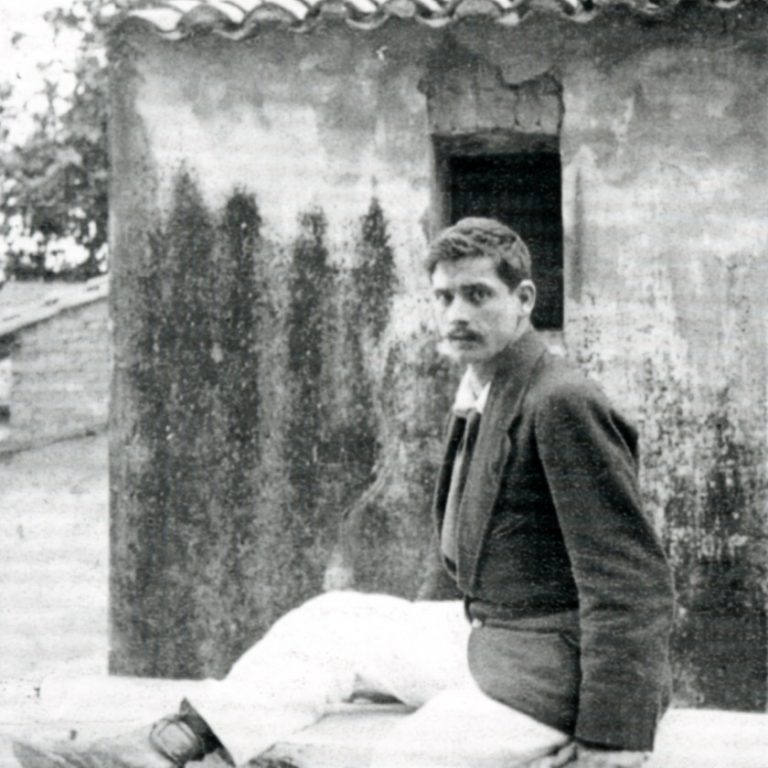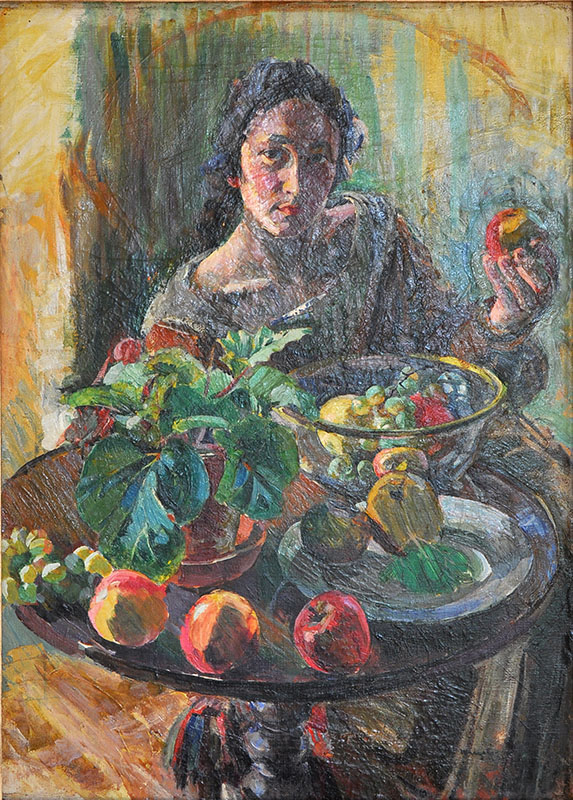Franz Wiegele, Die glückliche Familie (Ausschnitt), 1932-33, Privatbesitz
Franz Wiegele
(1887-1944)
Franz Wiegele was born on February 23rd, 1887, the third of four children to the couple Gertrud and Franz Wiegele Sr. in Nötsch. The father was a machine fitter and ran a smithy in Nötsch. With his younger brother Alfred (1892 – 1979) he attended lower school in Trieste, but in 1900 changed to the secondary school in Klagenfurt, from which he graduated in 1905. During his school days, he was particularly enthusiastic about drawing lessons, which based on templates, plaster models and nature. Wiegele’s first drawings and painterly attempts are therefore precise, natural reproduction of the individual objects.After Franz Wiegele had worked in his father’s smithy for a year, in 1907, probably at the suggestion of his Nötsch painter friend Sebastian Isepp (1884 – 1954), he began studying at the Academy of Fine Arts in Vienna, where he first attended the general painting school with Professor Christian Griepenkerl, then attended the special school for painting under Professor Heinrich Lefler and Professor Rudolf Bacher. In 1908/09, he received a state grant and in 1909 he was awarded the Dessauer Prize.
However, the artistic influences that shaped Franz Wiegele did not come so much from his teachers as from the cultural atmosphere of the city and his social relationships with intellectuals and fellow artists. At the same time, a boy named Anton Kolig from the Moravian Neutitschein (1886 – 1950) also entered the Vienna Academy. A friendship quickly developed between the two aspiring painters, which also became a family relationship in 1911 through Kolig’s marriage to Wiegele’s sister Katharina (1885 – 1971). Another fellow student at the academy was Egon Schiele (1890 – 1918), with whom he remained in contact with until his early death. In response to dissatisfaction with the established teaching- and art business, on June 17th, 1909 some students led by Schiele formed the “Neukunstgruppe” (New Art Group). Franz Wiegele was one of the founding members of this association, which was decisive for Austrian modernism. What they had in common was primarily their opposition to academic teaching and the departure from tradition and aesthetic conventions; however, they did not represent a uniform concept of art or similar stylistic creative methods. As early as December 1909, the first exhibition of the new art group took place in the Vienna art salon “Pisko” on Schwarzenbergplatz. In February 1911, the gallery organized the trend-setting “Special exhibition for painting and sculpture” in the rooms of the Vienna Hagenbund, at which Franz Wiegele’s first major work was shown, the „Nudes in the forest” (1910), along with nine of his drawings. Franz Wiegele traveled with his brother-in-law Anton Kolig and Kolig’s family to Paris on November 4th, 1912, to start a stay in France for several months with the two young artists through Carl Moll (1861 – 1945) and Gustav Klimt (1861 – 1918) thanks to the Kathi Fröhlich Foundation of the municipality of Vienna and private patrons. He took his painting, “Nudes in the forest” with him there. In Paris, he was mainly concerned with studying the works of old masters in the Louvre, therefore his own artistic production was low at that time.
In 1913, Wiegele undertook a study trip to Holland and Alsace to Grünewald’s Isenheim Altar in Colmar. He spent the summer with the Kolig couple and the children of Thaddäus and Marie Antoinette in Ambleteuse, a small fishing village near the northern French port city of Boulogne-sur-Mer, where his mother Gertrud also visited him briefly. In May of 1914, he embarked on a longer trip to North Africa, which led him to Algeria and Morocco. The city of Tlemcen, a commercial center located southwest of Oran, was his base, from where he made inland trips. At the beginning of June, he worked with the German painter Max Burchartz (1887 – 1961) and his wife Gertrud on an expedition to the desert town of Figuig in the far southeast of Morocco on the edge of the Sahara. Surprised by the outbreak of the First World War, Wiegele was arrested by the French in Algeria, temporarily held in Oran and finally assigned to labor in a camp for rebellious Arabs in Sebdou near Tlemcen. After a serious lung disease, Wiegele was transferred to an internment camp on the island of St. Marguérite near Cannes in mid-May 1916. Towards the end of the year, the painter was transferred to Zurich as an exchange prisoner for recovery in the Lenzerheide sanatorium near Chur through the mediation of the Austrian envoy. In May of 1917, Franz Wiegele moved to Zurich and began to build a new life there as a freelance painter on the advice of his Nötscher relatives. He soon made social contacts and traveled in social circles, which, in addition to relationships with fellow artists and writers, also gave him access to well-known Swiss collector families. The Reinhart and Gonzenbach families were among his patrons and friends during the Swiss years, the lawyer Gottfried Stiefel and his sister Lise Rioult, the composer Othmar Schoeck, the painters Ernst Morgenthaler and Karl Hofer and the sculptor Hermann Haller, the writer Hermann Hesse and the dancer Luise Zodel. As a result, there were numerous portrait orders, which offered him a certain level of material security. He also got his models from this circle of acquaintances. During the summer months, Franz Wiegele regularly visited his mother and the Kolig family in Nötsch.
In 1927, Franz Wiegele closed his studio in Switzerland completely and finally returned to Nötsch. He then lived in the same household with his mother Gertrud. Wiegele started to work on the large-format group portrait “Family portrait of Hubert Isepp”, which was acquired a year later by the Österreichische Galerie Belvedere in Vienna. Alfred Wiegele, who had converted a paint mill into a new grain mill in Nötsch, financed the construction of a house with a studio for his brother Franz near his own family villa. In the following years, he became the most important patron of the painter. In 1932/33, Wiegele’s main work of his time in Nötsch was created, the great family portrait of Alfred Wiegele, “The happy family”. In addition to painting, he also devoted himself passionately to hunting and rose growing. Franz Wiegele became friends with Otto Zernatto, the brother of the State Secretary and poet Guido Zernatto, who became his favorite hunting friend. In 1937, severe eye problem began to hinder the artist’s eyesight and caused a limitation in his painterly work. Therefore, he devoted himself increasingly to sculptural works. Wiegele made a series of portrait busts and heads, mainly using his mother as a model. Finally in1938, through therapy by the Klagenfurt eye specialist Dr. Adolf Purtscher, Wiegele was finally able to regain his eyesight. On 17 December, bombs hit Franz Wiegele’s home- and studio house, The artist, his mother Gertrud, his sister Hedwig Fina (1883 – 1944) and their foster daughter Maria Kassin (1927 – 1944) were found dead and many of his works were destroyed.
Auszug aus der Datenbank




